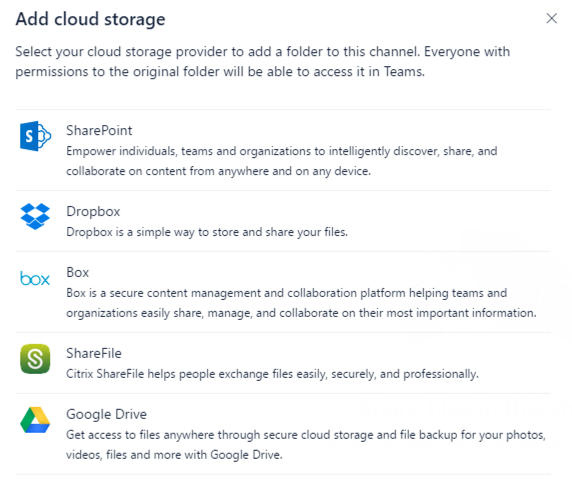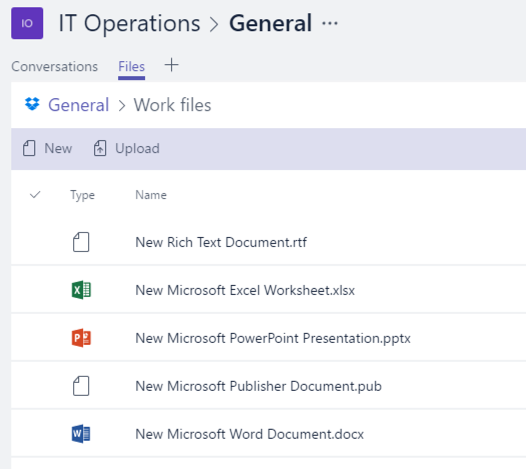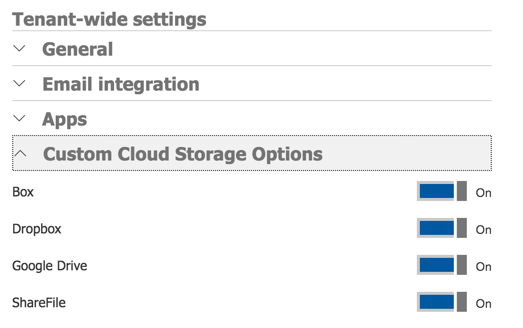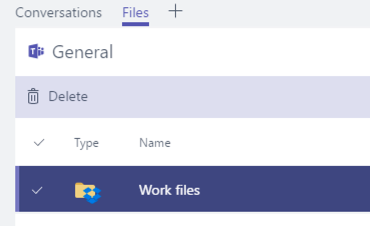Microsoft Teams now has the ability to connect to external cloud storage providers such as Dropbox and Google Drive. This change is rolling out to Office 365 customers now, and is enabled by default.
Microsoft takes a reasonably open approach to third party integration with their apps these days, especially cloud storage apps. The reality of course is that Microsoft’s own file storage solution, OneDrive for Business, has a patchy reputation for reliability and functionality, which means a lot of Office 365 customers ended up using third party services for file storage. Naturally Microsoft would like those customers to make use of Teams and other Office 365 apps, so integration is necessary. OneDrive for Business also has different use cases than other services, for example Dropbox works well for small teams as a file server replacement without a lot of complexity involved in setting it up, whereas OneDrive is a sync client that works with SharePoint-based stores which require more expertise to set up. Simply put, there’s a lot of non-Microsoft cloud storage usage out there, and integration with Teams helps it compete with other team chat apps.
For the end user, the option to add cloud storage is available in the Files tab of a Teams channel.

The user is prompted to authenticate to their cloud storage provider, such as Dropbox.

After adding a folder from cloud storage, the files will be accessible in Teams for any user who can authenticate to the same storage server and who has access to those files. For example, if Dave Bedrat adds a Dropbox folder to the IT Operations team, other team members such as Jane Tulley can’t access the files with their own Dropbox credentials if Dave has not shared the folder with them.

After the files have been shared and accepted in Dropbox they will be accessible by Jane in Microsoft Teams.

For organizations that do not want to allow access to cloud storage services there are controls available in the Office 365 admin portal. Navigate to Settings, Services & add-ins, and open the Microsoft Teams settings. You can disable some or all of the storage services here. It’s possible that in future other storage services will be added to Teams, so keep an eye on your Message Center notifications so that you can revisit these settings again in future when necessary.

In my testing the change took about 30 minutes before the Teams clients lost access to the options to add third party cloud storage to their channels. The Dropbox folder remained visible in Teams, but could not be opened. The only option available was to delete it.

The “Delete” button should probably be renamed to “Remove” since that is what it really does. The folder contents themselves are not deleted, and the dialog that pops up to confirm uses the word “Remove” which is a better description of what is happening. The user is also told they can add it back any time, even if all of the cloud storage options are disabled by an administrator, which is a bit misleading but probably won’t cause many issues.

If you decide to turn off cloud storage for Teams, and there’s a chance that your users are already making use of the feature, then you’ll need to plan how to communicate the change. Teams itself doesn’t surface any reports to indicate who is using what, so there’s no easy way to find out who is already using cloud storage. If your organization is already using Cloud App Security to discover app usage then that might give you some clues. Otherwise, you’ll just need to come up with the best communication plan that suits your organization.



Well M$ always changes there site structures at random so these settings are now no where to be found. MS365 is a clusterfu….. of a mess to Deals with …..
Hello! I read your article on third-party cloud storage, and I found it to be very informative. Your article provides a great overview of the benefits and drawbacks of using third-party cloud storage providers, and you provide some helpful tips for businesses that are considering making the switch.
Keep up the great work!
For some more information about us please refer https://tapestodigital.co.uk/cloud-storage
Thank you for sharing your knowledge and expertise in this area. Your article has given me a better understanding of the benefits and potential risks of using third-party cloud storage, and I’m confident that I’ll be able to make a more informed decision. Keep up the great work!
refer more details about cloud storage: https://tapestodigital.co.uk/cloud-storage
We have removed this option from Teams, but it is still available in Exchange Online. Is there a similar option to remove this from Exchange?
Replying to myself, but have been doing some digging on this, and the default options for additional cloud storage is controlled by the default OWAMailboxPolicy, in Exchange Online. It can be turned off, but there doesn’t appear to be any monitoring available of who may have been utilising this, which is on by default in all Exchange Online deployments!!
Thank you for this! I’m toying around with creating a Team for my small team within a relatively large company. Within the test team I created I selected Files > Add cloud storage > Sharepoint. I then linked to our team’s already set-up folder within the larger company SharePoint page. After playing around with that, I wanted to remove connection and when I clicked the menu option for the SharePoint folder, I was presented with TWO “Delete” options. That’s right. No description, no additional explanation. Just two delete options. After being scared for a while, not wanting to actually DELETE the whole department folder, I found this website. After clicking on each, I was presented with different confirmation dialogs: one to move folder to recycle bin (No) and the other to remove from this Team (Yes). Whew! That was scary
I dont find the option “service & add-in” in office 365.
there an any option to disable one-drive permanently?
Good information Paul. Is the 3rd party cloud storage on or off for all teams and users? Is it possible to limit how can add storage to a team, or is this only configured at the organizationlevel?